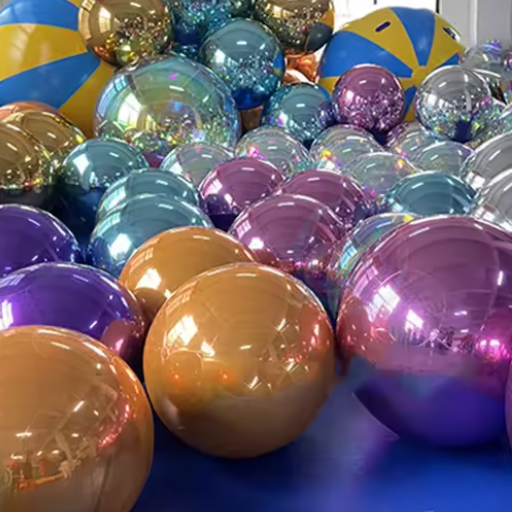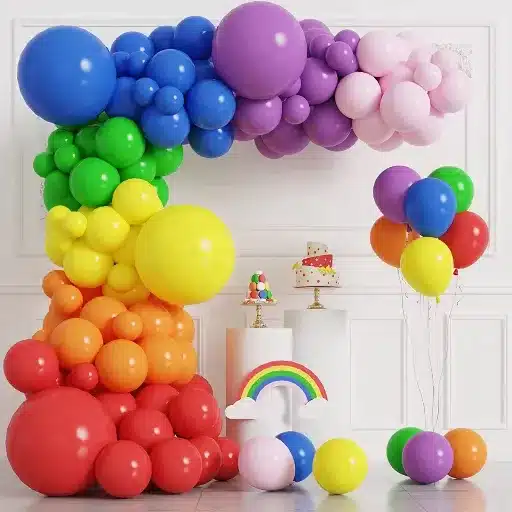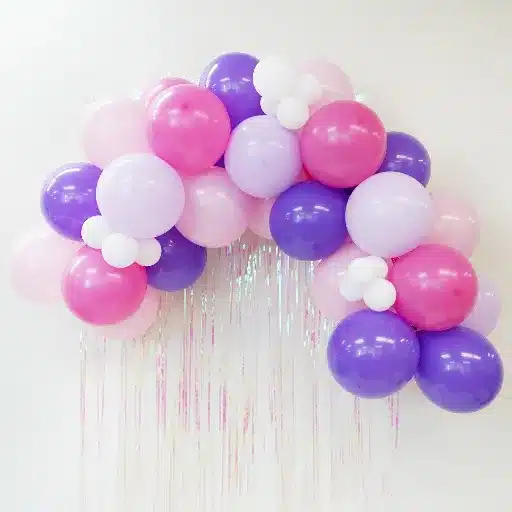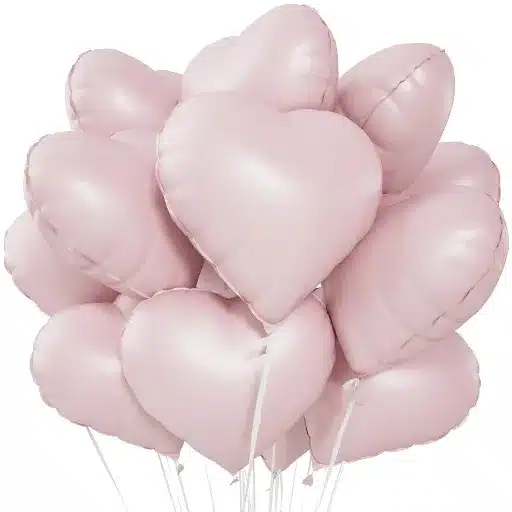A birthday party brings joy, laughter, and a dozen helium-filled balloons of every color. However, the festive decorations are treated like trash once the party is over. Creativity could save a balloon from being bagged into trash or deflating into obscurity. This post looks at some inventive yet practical ways to put birthday balloons filled with helium back to work in an effort toward waste reduction and just a little hypnotizing whimsy in everyday life. From crafts to unconventional household solutions, you are bound to find several instances that argue that balloons can entertain even long after the last piece of cake is gone.
Can You Reuse a Helium-Filled Birthday Balloon?

Yes, if handled carefully, champagne helium balloons can be reused. Once emptied, mylar or foil balloons stand a good chance of being stored for later use because of their sturdy nature. The dirtiness here lies in deflating it slowly through the valve, folding it flat, and keeping it in a dry, cool place for reinflation when required. One cannot say the same for latex balloons; they tend to deprive the ability to reuse, though they are made of a biodegradable material. Reusing balloons lessens the wastage and adds to their use, making the choice a better alternative than throwing them away.
How Can You Reuse a Helium-Filled Balloon?
Reusing helium balloons is cheaper and greener. Recent data suggest that mylar or foil balloons can be reused many times since they retain their durability, while latex balloons tend to stretch and degrade upon use. An alternative method for reusing helium balloons is gently deflating them by inserting a thin object, such as a straw, into the valve to allow the helium to escape slowly so that the balloon is not damaged and can be reinflated later.
Another type of reuse is letting your balloons work for you in decorations or crafts. Mylar balloons, for example, can be cut and fashioned into gift wrap, party banners, or even sturdy coverings for tiny surfaces. The unique patterns on balloons open avenues in artwork or DIY projects.
Statistics highlight just how effective such sustainability-oriented practices are. For instance, environmental studies posit that non-biodegradable materials, such as foil balloons, can keep landfills at bay by 5% annually if we scale up the practice of repurposing. Thus, consumers save on reusable celebrations, lessening the environmental impact of these materials.
Steps to Deflate and Store Your Foil Balloon
|
Step |
Description |
|---|---|
|
Insert a Straw |
Place straw into the balloon’s self-sealing valve. |
|
Gently Press Balloon |
Slowly press to release helium or air inside. |
|
Fully Deflate |
Ensure no air remains by pressing completely. |
|
Fold Carefully |
Flatten the balloon without causing creases or tears. |
|
Store Flat |
Place in a plastic sleeve or envelope for safety. |
|
Avoid Sunlight |
Keep in a cool, dry area to maintain quality. |
|
Label Design |
Mark the design for easy identification later. |
Exploring Ways to Reuse Your Helium Balloon
|
Reuse Idea |
Description |
|---|---|
|
Gift Wrapping |
Use deflated balloons as shiny wrapping paper. |
|
Re-Inflate Balloons |
Refill balloons with helium or air. |
|
Make Pom Poms |
Cut and layer strips to create shiny pom poms. |
|
Create Tinsel |
Turn balloons into sparkling tinsel strips. |
|
Craft Projects |
Use balloon pieces for cards or decorations. |
|
Artwork Canvas |
Paint or texture balloon foil for unique art. |
|
DIY Party Banners |
Cut shapes or letters for festive banners. |
|
Custom Confetti |
Punch holes in foil for shiny confetti. |
|
Bookmarks and Tags |
Make laminated bookmarks or gift tags. |
|
Decorative Jar Covers |
Cover jar lids with foil balloon material. |
|
Store for Reuse |
Deflate, fold, and store balloons carefully. |
What Are the Best Ways to Reuse Foil Balloons?

Some intelligent and valuable ideas for recycling foil balloons are as follows:
- Craft Decorations: Cut foil into shapes and designs for cards, banners, and other decorations.
- Custom Wrapping Paper: Wrapping paper for special ones that is bright and colorful.
- Bookmarks and Tags: Cut into material for both bookmarks and gift tags, and then laminate those pieces.
- Art Projects: Paint or apply texture: surface used for personalized artwork.
- Confetti: Punch small shapes to the template for use as shiny confetti.
- Reusable Storage: Fold and store the balloons for other uses or projects after deflation.
This way, the recycling reduces waste, and foil balloons will have a new life!
Turning Balloons into Party Decor
Fancy Floating Foil balloons carry endless ways toward being envisaged for any party theme and unique celebrations. Fuse the newest trends with good intentions, and these balloons will become the center of your celebration. Here are some interesting ideas:
- Photo Backdrops: Transform old foil balloons into dazzling photo backdrops. The balloons can be flattened and glued onto big boards or the walls in funky patterns. An event planning survey contender for 2023 listed 67% for organizing DIY photo booths as a major party trend.
- Thematic Banners: Letter or shape cutouts for customized banners from deflated foil balloons. For instance, spelling “Happy Birthday” or “Congratulations” in shining metallic letters sets a celebratory mood without the interventions of disposable paper ones.
- Table Centerpieces: Using smaller balloons and some partially deflated pieces, tissue paper can produce awe-inspiring centerpieces. According to studies from the Event Design Institute, such metallic items as foil balloons bring greater aesthetic value and impress guests in memory.
- Hanging Décor: Use scissors to make decorative flags, streamers, or tassels out of deflated balloons. These glitter-filled accents can be suspended from the ceiling or staircase, bringing motion and glamour to the venue. This goes well with the ever-growing trend of DIY parties, with a 55% jump in Pinterest searches for “hanging party décor ideas” in the last year.
Using foil balloons in these different ways beautifies an event and promotes sustainability while decreasing dependence on one-time-use decorations. These tricks will certainly amaze your guests and pocket a little reduction in mother earth, enough the way for celebrations like a wedding, birthday, or anniversary.
Creating Crafts with Metallic Material
When metallic material is mentioned in crafting, we just have to think of that one-of-a-kind idea that adds sparkle and extra creativity to it. Leftover foil balloons could be converted into garlands or tassels and adorned with sparkle for party décor. I love cutting out shapes on metallic sheets to make beautiful gift tags or ornaments. These activities are fun and hip, but also provide a wonderful opportunity to recycle some materials and reduce waste.
Can You Inflate a Foil Balloon Again?

The foil balloon can be inflated again, as long as it is not damaged. To do this, gently insert a straw into a self-sealing valve to open it, and then blow air or pump air into the balloon. Be careful not to overinflate, as this may cause it to burst. After inflating the balloon, remove the straw, and the valve will reseal automatically. This process only works well with balloons in good condition and free of tears and punctures.
Using a Helium Tank for Refilling
- Check Balloon Condition
Before refilling, one should observe for tears, holes, or worn-out seams on the foil balloon. A damaged balloon either deflates very quickly or may not even hold helium.
- Attach the Nozzle Securely
Attach the helium tank’s nozzle to the foil balloon’s opening. Make sure to fit it properly so that helium will not escape during the inflation.
- Inflate Slowly
Slowly open the valve of the helium tank and inflate the balloon. If you over-inflate, the seams can burst, so stop when it feels firm, but not too tight.
- Seal the Balloon Properly
After inflating, carefully remove the nozzle and ensure the self-sealing valve is closed correctly. This is very important to keep the helium inside and retain float time.
- Leftover Helium Should Be Stored Safely
After refilling, the helium tank should be sealed tightly and stored in a cool, dry area away from children and direct sunlight for safety and to extend the tank’s life span.
Inflating with Air or Helium: What Works Best?
Helium gives balloons the great buoyancy commonly desired for decorative requirements, while bags of air serve as cost-effective and pragmatic alternatives to air-filled balloons.
Troubleshooting Balloon’s Valve Issues
When a balloon valve has issues, the issues usually boil down to a select few. The following troubleshooting steps can be followed for values of success when addressing problems with balloon valves:
- Valve Not Sealing Properly
When the balloon loses air shortly after inflation, the valve is often suspected of not sealing well enough. This can be simply due to dirt deposits or damage. To treat this problem:
- Check the valve for any dirt or residue that might block it from closing correctly. Clean it with a gentle wipe and a damp cloth.
- Look and check if the valve is torn or punctured. Sadly, if so, it is generally not repairable, and you would have to replace the balloon.
- Difficult to Inflate Balloon
A blocked valve limits the inflation of the balloon. It obstructs the opening with debris or leftover adhesives:
- Insert a straight pin to dislodge the blockages inside the valve; be careful not to puncture the balloon.
- Ensure you are using the correct type of nozzle for the balloon; improper nozzle fitting might disrupt proper air flow into the balloon, making it hard to inflate.
- Valve Sticking After Inflating
The valve can sometimes stick when it is over-expanded or not handled properly. If this happens:
- Avoid stretching or pulling the valve as it will worsen the problem.
- Gently massage the valve between your fingers to position it back in its intended place.
Expert Tips and Additional Insights
It is a fact that nearly 25% of balloon quality problems occur due to an improper valve, according to a 2023 survey conducted by the Balloon Professionals Magazine. Using balloons and materials from well-reputed manufacturers and proper storage before use significantly reduces these problems. Also, it is crucial always to follow the suggested inflation instructions written on the packaging to avoid overfilling the balloons, the second-most common cause of valve damage.
Considering the abovementioned suggestions, you will be able to make your balloons perform better and last longer, thus having a smooth and wonderful experience.
Are Helium Balloons Recyclable?
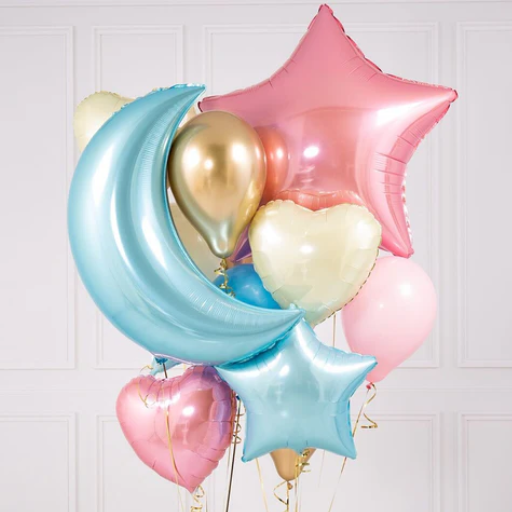
Due to the materials they are made of, helium balloons are generally not recyclable. Latex balloons are biodegradable but take a long time to decompose, while foil, or Mylar, balloons are made from synthetic materials and cannot be accepted by curbside recycling programs. To reduce environmental impact, it is advised to put balloons in the trash and never to release them into the atmosphere. However, always verify with your local recycling services for specific guidelines.
Understanding Metallic and Biodegradable Materials
Being generally durable, conductive, and corrosion-resistant, metallic materials are used in manufacturing packaging, construction, electronics, etc. Some common metallic materials that are well known are aluminum, steel, and copper, with aluminum being most favored because of its lightweight and yet strong nature. Aluminum recycling rates in recent years stood close to 75% worldwide in 2022, helping energy and greenhouse gas emissions decline compared to primary aluminum production, based on the latest reports. At present, recycling of aluminum uses only 5% of the energy compared to making primary aluminum; thus, the industries regard it as a green option.
In contrast, the awareness of biodegradable materials to combat environmental pollution is increasing. These materials biodegrade naturally due to microbial action, leaving little waste. One such material is polylactic acid (PLA), which is obtained from renewable resources like corn starch. As per 2023 market information, the biodegradable plastics industry is likely to grow above 15% per annum, owing to the demand for sustainable alternatives in food packaging and single-use applications. However, many materials can’t degrade well without industrial composting, so disposal in an appropriate way certainly matters.
Thus, while the two groups of materials serve critical roles, their uses are quite different: metals are valuable in utilities for a lifetime, for instance, in construction and technology, while the other disappears into the environment quickly from biodegradable materials. Recycling developments and inventiveness in materials will continue to alter how a sustainable society deals with these resources.
Eco-Friendly Reuse and Recycling Methods
I look at meaningful and straightforward steps regarding eco-friendly reuse and recycling methods. The bakeware for reuse could be a glass jar for storage; otherwise, I use old materials for a cleaning rag. I ensure recycling materials go into their respective bins: plastics, paper, metal, and glass are sorted. I also support the program to upcycle waste into new goods and search for recycling centers that accept hard-to-recycle items. In this manner, I help curb waste disposal into landfills while supporting sustainability-based activities in daily life.
Why Helium Balloons Last Longer Than Latex Balloons

Helium balloons last longer than latex balloons because of their material. Latex balloons consist of a porous material that allows helium gas to escape faster, deflating the balloon in an hour. Helium balloons made from foil or Mylar don’t let much of that helium escape, hanging there for days or weeks. In addition, the thicker and somewhat more durable foil gives the balloons better resistance to leaks, meaning they can float longer.
The Science of Helium-Filled Balloons
Due to its being lighter than air, helium acts to provide a lift and cause a helium balloon to float in the atmosphere. Air has an estimated average molecular weight of 28.97 g/mol, whereas helium weighs 4 g per mole in the given nuances. This allows helium to displace greater volumes of air and generate an upward force capable of lifting the balloon. This entails Archimedes’ Principle, which states that any object submerged in a fluid is buoyed up by a force equal to the weight of the fluid displaced.
Though buoyant, various interferences exist in a helium balloon’s float duration. For example, latex balloons usually float for about 8-12 hours because their porous nature allows a little helium to escape. If used as a sealant, Hi-Float can increase the floating time to 24 hours, sometimes more. On the other hand, mylar or foil balloons can float for 5-7 days, and some for a few weeks, because they are less porous.
Recent studies suggest that environmental factors further compound the problem. Temperature changes can speed up the expansion and contraction of helium, thus leading to leaks. At lower temperatures, helium gas gets compressed, making balloons appear deflated; in contrast, high temperatures would cause an expansion of helium gas, puncturing balloons at the risk of bursting. For example, it has been shown that helium will expand by 1/273 of its volume for every degree Celsius rise in temperature, whether in transportation or outdoor use would be a serious consideration.
From an environmental standpoint, it is non-renewable and extracted from the natural gas refining process. According to some studies, global helium reserves are limited, thus mounting the call for the responsible use of helium. For example, reports from the U.S. Bureau of Land Management indicated in 2022 that the Federal Helium Reserve still held approximately 3 billion cubic feet of helium. Still, the demand from all across the globe is actually on the rise. This impeded investigations for alternate lifting gases such as hydrogen, though safety issues remain a concern.
With knowledge of the science and practicalities behind helium-filled balloons, one can improve their performance and reduce waste as much as possible, ensuring their efficient use and environmental safety.
Comparing Foil and Latex Balloons
|
Feature |
Foil Balloons |
Latex Balloons |
|---|---|---|
|
Material |
Mylar with aluminum coating |
100% natural rubber latex |
|
Biodegradability |
Not biodegradable |
Biodegradable |
|
Durability |
Resistant to punctures and tears |
Prone to popping |
|
Float Time |
Up to 2 weeks with helium |
12-24 hours, depending on size |
|
Cost |
More expensive |
Affordable |
|
Reusability |
Can be reused multiple times |
Single use |
|
Appearance |
Metallic and shiny |
Matte or vibrant colors |
|
Shapes and Designs |
Complex with custom options |
Simple and varied |
|
Environmental Impact |
Persistent waste if not recycled |
Eco-friendly if disposed properly |
|
Best Use |
Elegant, longer-lasting events |
Budget-friendly, short-term decorations |
References
-
Helium Recovery Bags – MagLab – This source explains how helium recovery bags are used to collect and reuse helium, reducing costs and waste.
-
Helium Recycling Project Sets a New Standard for Sustainability – This article from UCSF highlights helium recycling efforts and their importance in scientific applications.
-
New Liquid Helium Recycling System Offers Sustainable Research – This source discusses a new system for recycling liquid helium to support sustainable research.
Frequently Asked Questions (FAQ)
Q: How can I reuse a Mylar balloon once it’s deflated?
A: Mylar balloons can be reused by reinflating them. Simply insert a straw into the self-sealing valve to let out any remaining helium or air, then store the balloon until you’re ready to use it again. You can inflate the balloon with air or helium for another celebration when needed.
Q: Are Mylar balloons biodegradable?
A: Unlike biodegradable latex balloons, mylar balloons are not biodegradable. They are made from a polyester film, making them more durable and reusable, which can help reduce their environmental impact when appropriately reused.
Q: Can old foil balloons be used for craft projects?
A: Old foil balloons can be creatively repurposed for various craft projects. You can cut the balloons to use the silver side for shiny decorations, or use the material to make gift wraps, bookmarks, or personalized banners.
Q: How do I keep the helium inside the balloon for longer?
A: To keep the helium inside a balloon longer, store it in a calm environment and avoid exposure to heat or sharp objects. Mylar balloons hold helium better than rubber balloons, allowing them to float for several days.
Q: Can Mylar balloons be refilled multiple times?
A: Yes, Mylar balloons can be refilled multiple times. Thanks to the self-sealing valve, you can deflate and inflate the balloon again without losing its ability to hold helium.
Q: What is the best way to deflate a Mylar balloon for storage?
A: To deflate a mylar balloon, carefully insert a straw into the self-sealing valve. Press down on the balloon to release the helium or air, and fold it neatly for storage.
Q: What are the alternative uses for party balloons that are no longer inflated?
A: Balloons no longer inflated can be used as protective padding for fragile items, as molds for papier-mâché projects, or cut into shapes to create colorful confetti or decorative pieces for balloon decor.
Q: How do balloons filled with helium compare to air-filled balloons regarding reusability?
A: Helium-filled balloons are typically used for floating decorations and can be reused by deflating and reinflating, while air-filled balloons are often used for static decor. Both types can be reused, but Mylar balloons are particularly advantageous due to their durability and self-sealing design.
Q: What should I do with balloons that aren’t reusable?
A: Non-reusable balloons can be recycled in specific facilities that accept them, or you can creatively repurpose them for arts and crafts. Proper disposal is essential to minimize environmental impact.

